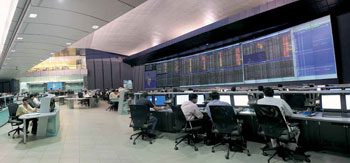How Network Operations Centers Influence Mainstream AV Integration
Shen Milsom & Wilke installed Barco display and processing at Reliance Infocomm in Mumbai, India.
In a way, they are this industry’s version of a Formula One racecar: Boasting the highest-quality audio and video systems on the market, today’s network operations centers (NOCs) feature the ultimate in command and control. And, much like Formula One, the systems designed for NOCs have a significant influence on those we see in other spaces, such as conferencing facilities.
“They are the early adopters of high tech, and they are an important part of our business because they drive the market,” said Chuck Collins, vice president of sales at Digital Projection International. He noted that the demands associated with NOCs benefit other markets, especially in relation to resolution and cost of ownership. “We enjoy working in that market because it’s always a challenge; it’s kind of rarified, but it slowly trickles down into the mainstream.”
Scott D. Norder, vice president of marketing at RG B Spectrum, notes that this trend also applies to displays. “There are some interesting new display technologies that are being targeted toward control rooms, and that have trickled down to produce highquality displays in boardrooms and conference rooms,” he said. “Some of our display partners are doing both rear-projected and front-projected as well as LCD displays, plus micro-tiles that give designers of any digital solution a broad palette of technologies to choose from.” The emphasis, he said, is on appropriately matching ambient light with usability and flexibility. “Because control rooms have had all of these requirements, they have created a plethora of solutions for the smaller rooms as well.”
But what about all of the sources that are out there? RGB’s Norder assured that his company loves this challenge: “Our product portfolio—including codecs providing video over IP , as well as cross-format matrix switchers—allow you to take all of these sources in, whether they do legacy analog all the way through to super high-quality dual-link sources into an end display on your video wall.”
In applying this flexibility, integrators give their clients the option of future-proofing their systems—although more and different inputs means that cabling selections are extremely important. “In our training, we do help integrators understand that their choice of cabling matters, such as the quality of your DVI cables and the maximum length you can run,” Norder added. “We will take them through how you clean fiber to make good fiber connections, and what your limitations on fiber, fiber bends, and fiber handling are.” RGB also provides information on the advantages and disadvantages of Cat-5 and DVI versus other solutions, based on the application.
At the same time, integrators must still consider analog sources. “You have to support what’s already out there, but not necessarily drive new analog,” Norder said. “There are a tremendous amount of analog sources out there that have unique functionalities that need to be maintained, whether it be for the military, security or control rooms, or even certain conference rooms.” These sources, he added, can’t be done away with instantaneously.
As with everything AV, Norder pointed out that in control rooms, AV systems have converged with IT. “We see video over IP , video over Cat-5, and switching technologies—particularly in control rooms— touching the IT group,” he said. He noted that RG B’s MultiPoint KvM solution is one of the company’s products that address this trend. “There is a lot of collaboration between how you build and design your system for best flexibility and functionality on the AV side, as well as providing all of the security and data bandwidth required to deliver that solution, which brings the IT group into the equation.”
Margin Builder
LED illumination technology enables AV designers to offer clients a greater ROI, explained Chuck Collins of Digital Projection International: “The cost of ownership is a little higher, but when you consider that LED illumination lasts for up to 60,000 hours or even longer, this results in less labor to change lamps, and there is a lot less heat, which means less power and less air conditioning.”
Carolyn Heinze is a freelance writer/editor.
Commanding So Many Choices
Back in the days of NASA’s manned space launch command and control architecture, reams of data were divided into operational categories and then presented in “manageable segments” to multiple operators, explained Greg Lukens, vice president at the Wheaton, MD-based systems integration firm, Washington Professional Systems. These operators would each analyze their own segment before relaying either a “Go” or “No Go” message to the facility’s primary decision makers.
Today, things are different: “Go” or “No Go” is just the beginning. “Today an analyst can spot a valuable point of data, image, sound, or statistic and relay that data–as well as his opinion of the data’s value–on to the decision makers,” Lukens explained.
One of the most important steps in command and control center design is the initial one: Defining the facility’s “analytical pyramid.” What are the data sources? How many sources is data being collected from? How many “experts” are involved, and what are their disciplines? And finally, how many layers are there between the sources of collection and the final decision-maker? In other words, how does data move up the pyramid?
“The challenge in designing the command and control centers of today,” Lukens said, “is to combine many differing data types, make them available to many levels of management personnel, and allow for the analyzed information to be directed to those that must make the choices of the mission’s direction.”
—Carolyn Heinze










